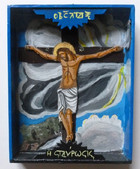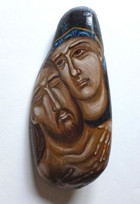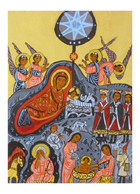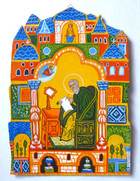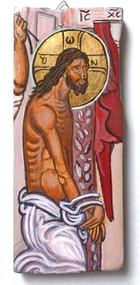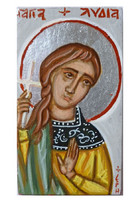Eka and Eri Fragiadaki
Eka and Eri Fragiadaki are mother and daughter icon-makers with a mission. On the Greek island of Crete where they live, there is still a demand for holy images, particularly icons, to mark important events like baptisms, weddings and funerals; serve as “ex voto” gifts for answered prayers; or be used in private devotions. The choice for buyers has usually been between elaborate (and expensive!) handmade works and cheap, mass-produced reproductions. The Fragiadakis want to change all that.
The two women are committed to making sacred art in what Daughter Eri calls “the space in between.” As she explains: “We want to create affordable artifacts that are made by hand, unique little pieces that ordinary people like ourselves can purchase and enjoy. Icons should be accessible to all people, for the assistance, consolation and healing they provide to the human heart and spirit.”
To reduce costs, the Fragiadakis sand wooden panels and apply gesso, themselves, preparing their own egg tempera paints from dried pigments and varnishes with beeswax in the time-honored way of making icons. They favor smaller pieces with simpler themes. Since their modestly priced sacred art appeared on-line in 2010 at their Angelicon website, they have found buyers, not only in Crete, but around the globe.
The Angelicon workshop is located in an old warehouse in the Cretan capital of Heraklion. Rows of gilded icons gleam from shelves along its concrete walls. Small reproductions hang as decorations from a dried tamarisk shrub. Others find their way into pouches with sugar-coated almonds as wedding or baptism “favors.” Eri photographs finished pieces in still lifes with blossoms from their garden. Dried lavender sprigs are enclosed in their parcels.
The mother and daughter icon-makers work side by side at their easels, collaborating on large commissions but mostly pursuing their own artistic interests. Eka has a special touch with icons of the Virgin Mary but enjoys experimenting with holy images in the Coptic style or replicating Greek folk art pieces like the metal shadow box Crucifixion scene in the collection, similar to ones that hang on the wall of village bedrooms adorned with flowers.
Eri likes to paint icons on unusual surfaces like “repurposed” wood and stone. Her image of the Good Shepherd in the collection preserves the jagged outlines of the cross section of olive tree branch on which it is painted. A tear drop-shaped piece of driftwood from a nearby beach serves as the ground for a poignant, tightly-composed image of the Lamentation of Christ, familiar to Western Christians as Pieta.
The Fragiadakis are respectful of their Byzantine heritage. The Nativity scene in the collection copies an image in encaustic at the St. Catherine Monastery in Sinai, dating from before the 8th- 9th century iconoclastic controversies. The icon of St. Gregory the Theologian on gessoed cardboard is taken from a 12th century illuminated Greek codex in the Sinai monastery library. A 14th century fresco in the Vatopaidi monastery at Mt. Athos provided inspiration for the collection image on recycled wood of the Flagellation of Christ.
Eri represents the third generation of women in her family to make religious art objects. Her great grandmother, Evangelie, was skilled at embroidering priestly vestments, one of countless self-taught “hidden” women artists whose contributions to church art have gone unrecognized down the centuries. Times are changing. Eka is trained in icon-making and art restoration, and Eri studies Byzantine painting with Cretan Iconographer Antonis Theodorakis.
Eri is particularly drawn to the theme of women and sainthood. One image she believes is "essential to have in my shop" is an icon like the one in the collection of St. Lydia of Philippi, the seller of purple dye or cloth, mentioned in Acts 16: 14-15, 40. Lydia was the first European convert to Christianity, honored in the Eastern Orthodox Church as "the Equal of the Apostles," and a woman of sufficient means to have provided hospitality and refuge to St. Paul in her "household." What better role model could a modern women icon-maker find than this successful 1st Century Christian business woman?

